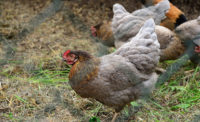A Bacterial Virus Helps Spread Salmonella

Salmonella is associated with a large number of cases of foodborne infection resulting in diarrhea and, in some cases, more severe complications. Half of all Salmonella infections in the European Union are linked to pigs, and a new strain called ST34 is currently dominant in this livestock animal. ST34 has now spread in pig populations worldwide and is pandemic.
The ST34 strain is a type of Salmonella Typhimurium, which accounts for a quarter of all Salmonella infections. New multidrug-resistant (MDR) strains of Typhimurium are known to have emerged repeatedly since surveillance records began over 60 years ago. In the UK, over half of all Typhimurium infections are now caused by the ST34 strain. Typhimurium has been increasing as a proportion of all Salmonella infection for more than a decade, largely due to the emergence of this new strain in pigs.
Salmonella Enteritidis has been largely controlled in layer hen flocks, but in the UK, little headway has been made in intervening years to control Salmonella Typhimurium. Replacement of the dominant MDR epidemic strain of Typhimurium responsible for causing disease may make this a moving target for interventions. Therefore, understanding why new strains emerge and what makes them distinct from previous strains is important to devise the best ways of tackling this pathogen.
Viruses are well known for causing some of the worst infections in people throughout history, and the current pandemic SARS-CoV-2 is no exception. They are very small packages of genetic material that require the cells of a host organism to replicate their genetic material. In doing this they cause disease. There are also viruses, called bacteriophages, that use bacteria to replicate and, in doing so, kill the bacterium. Some, however, also have the ability to hide inside the bacterial cell by merging with the bacterium’s genetic material.
This is what appears to have happened perhaps hundreds of times during the emergence of the ST34 pandemic strain and has helped these bacteria spread globally.
Our research group, working with Public Health England (PHE), Animal and Plants Health Agency, the Earlham Institute, and Teagasc Food Research Centre, and funded by the Biotechnology and Biological Sciences Research Council, part of UK Research and Innovation, found that the common ancestor of the epidemic in UK pigs existed around 1995 but went unnoticed for 10 years until it became prevalent and was detected through surveillance by the UK government’s Animal and Plant Health Agency.
Analysis of the genome sequence from human infections using data from PHE indicated that a bacteriophage called mTmV infected ST34 on multiple occasions, beginning around 2002. This may explain why it became prevalent a short time later.
By analyzing the population structure of ST34, it was clear that Salmonella harboring the mTmV virus in its genetic material became more numerous over time and that it had gained a competitive advantage over its brethren lacking the virus. Inspecting the virus in more detail revealed that it carried a gene called sopE that encodes a “toxin” known to help Salmonella infect its animal hosts species, cause diarrhea and be passed on to new hosts in food and feed.
The mTmV virus seems to have been helping Salmonella spread, and because it was living in the Salmonella, it was aiding its own survival.
It is currently unclear whether the mTmV virus and associated SopE toxin increases spread of ST34 specifically within pig herds or if it can also increase the likelihood of entry into food and ultimately transmission on to consumers. Nonetheless, it is hoped that understanding how and why new strains of Salmonella emerge in livestock will help develop improved strategies to reduce its incidence, making our food supply safer and healthier.
Resource
https://www.microbiologyresearch.org/content/journal/mgen/10.1099/mgen.0.000456.
Rob Kingsley, Ph.D., is professor of microbiology at the Quadram Institute.
Looking for a reprint of this article?
From high-res PDFs to custom plaques, order your copy today!





